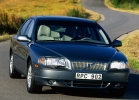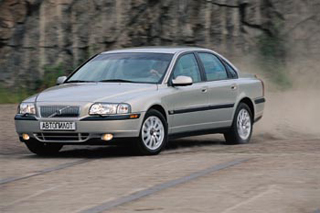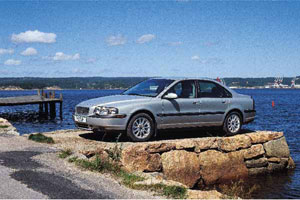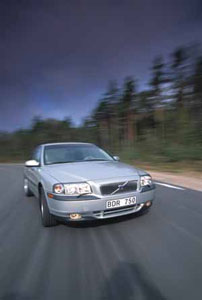Test drive Volvo S80 1998 - 2003 sedan
Electronic attack from the north
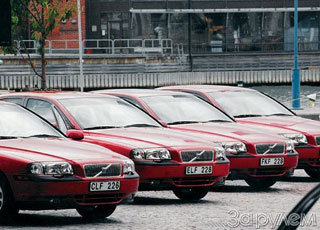 Try to answer, where you created a car with a device for continuous change in the phase of gas distribution, a super-compact gearbox, a gas pedal without a mechanical connection with a throttle, eighteen on-board computers, and even with a multi-fluent way of exchange of information and a mobile phone integrated in dashboard. Do you think that this is the description of the next Japanese miracle - the concept of the new millennium? No, this is a serial Swedish car Volvo S80, which replaced with rear -wheel drive models 940 and S90. There are so many technical innovations in it that a detailed acquaintance with everyone would take dozens of pages. Therefore, we will dwell only on the most interesting.
Try to answer, where you created a car with a device for continuous change in the phase of gas distribution, a super-compact gearbox, a gas pedal without a mechanical connection with a throttle, eighteen on-board computers, and even with a multi-fluent way of exchange of information and a mobile phone integrated in dashboard. Do you think that this is the description of the next Japanese miracle - the concept of the new millennium? No, this is a serial Swedish car Volvo S80, which replaced with rear -wheel drive models 940 and S90. There are so many technical innovations in it that a detailed acquaintance with everyone would take dozens of pages. Therefore, we will dwell only on the most interesting.  Only a sedan
Only a sedan We will not discuss designer delights, although they deserve it. We hope the reader from the photographs will make his own impression of the appearance of the Volvo S80. Obviously one thing - the car has its own face and, of course, will find many fans. With conservatism S90, especially the 940th is over. Instead of an angular body - a modern streamlined with good aerodynamics (CX \u003d 0.28), instead of longitudinally installed engines and rear -wheel drive - transversely located power units and front drive wheels. Actually, Volvo S80 is the first swallow of the new family. The Swedes have created a new large platform for a whole range of representatives of a representative class. At the same time, the S80 sedan was developed as an independent model, not aimed at making a station wagon on the basis of this body. And this means that the Volvo S80 will not be released in the modification of the V80 Isteit. The station wagon on the same platform will appear later and will be original both in design and in appearance.
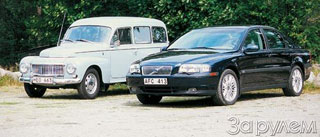 This year, Volvo S80 is equipped with four gasoline engines. All of them are the further development of fairly successful engines of the 850th series. The cylinders are located in a row, blocks and heads of blocks - from an aluminum alloy, four valves per cylinder, two distribution shafts. They are equipped with a system of continuously changed phases of gas distribution (its operation depends on the load on the engine, revolutions and other factors) and the latest electronics for controlling distributed fuel injection and ignition. So, for example, the gas pedal does not have a mechanical connection (cable or traction) with a throttle. It is equipped with a sensitive sensor that transmits information to the computer, and he, in turn, forms the command to add or drop gas.
This year, Volvo S80 is equipped with four gasoline engines. All of them are the further development of fairly successful engines of the 850th series. The cylinders are located in a row, blocks and heads of blocks - from an aluminum alloy, four valves per cylinder, two distribution shafts. They are equipped with a system of continuously changed phases of gas distribution (its operation depends on the load on the engine, revolutions and other factors) and the latest electronics for controlling distributed fuel injection and ignition. So, for example, the gas pedal does not have a mechanical connection (cable or traction) with a throttle. It is equipped with a sensitive sensor that transmits information to the computer, and he, in turn, forms the command to add or drop gas.  Two engines - five -cylinder with a working volume of 2 liters. The Volvo S80 T5 with high -pressure turbocharges develops a capacity of 166 kW/226 liters. With. and maximum torque 310 N.M, Volvo S80T with low -pressure turbocharged - 120 kW/163 liters. With. and 230 N.M. Fuel consumption in a mixed city cycle is 9.6 and 9.5 l/100 km, respectively. Two other power units are six -cylinder: atmospheric Volvo S80 2.9 with a capacity of 150 kW/204 liters. With. and Volvo S80T6 with a working volume of 2.8 liters and a capacity of 200 kW/272 liters. with., equipped with two turbochargers.
Two engines - five -cylinder with a working volume of 2 liters. The Volvo S80 T5 with high -pressure turbocharges develops a capacity of 166 kW/226 liters. With. and maximum torque 310 N.M, Volvo S80T with low -pressure turbocharged - 120 kW/163 liters. With. and 230 N.M. Fuel consumption in a mixed city cycle is 9.6 and 9.5 l/100 km, respectively. Two other power units are six -cylinder: atmospheric Volvo S80 2.9 with a capacity of 150 kW/204 liters. With. and Volvo S80T6 with a working volume of 2.8 liters and a capacity of 200 kW/272 liters. with., equipped with two turbochargers. In 1999, 2.4-liter gasoline engines (170 and 140 hp), as well as a 2.5-liter turbodiesel and a capacity of 103 kW/140 liters, will be replenished with the gamut of engines. With.
 Six - across
Six - across The Swedes were the first who managed to transversely place a row six under the hood. The addiction (and not V-shaped, as in most firms), the engine designers explain the volvo to several factors. They believe that with such a layout it is easier to make a spacious salon and ensure passive safety. In addition, the location of the exhaust manifold on one side of the cylinder unit facilitates the installation of a turbocharger and a catalytic neutralizer, which can be brought closer to the engine, where the exhaust gases have a higher temperature - which means that the neutralizer is warmed up and activated earlier. The unification of the entire family of engines plays an important role. It is still easier to fasten an additional cylinder to an already produced five-cylinder motor than to develop an original V-shaped six.
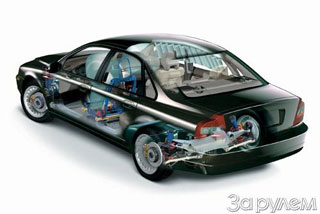 One way or another, and squeezing a six -cylinder colossus across was not easy. It was necessary to design a new extremely compact gearbox. The mechanical five -speed four -sneaker (!) Box M65 has become the shortest in the world! Its length is only 297 mm, which is 56 mm less than that of the previous owner of the record - the M56 box, which is equipped with a Volvo with a in -line five -cylinder engine.
One way or another, and squeezing a six -cylinder colossus across was not easy. It was necessary to design a new extremely compact gearbox. The mechanical five -speed four -sneaker (!) Box M65 has become the shortest in the world! Its length is only 297 mm, which is 56 mm less than that of the previous owner of the record - the M56 box, which is equipped with a Volvo with a in -line five -cylinder engine. No less interesting are automatic four -speed gearboxes created on Volvo, together with specialists, General Motors and the Japanese company Ainzin Warner. Pretty compact, they are able to adapt the transmission algorithm to the ride style of a particular driver.
An automatic box with a girtronic function is installed on the most powerful Volvo S80 T6. It allows the driver to switch the programs also manually. The control selector is transferred from the Drive position to the MAN position, and then it can be clicked as a racing gear lever with a sequential
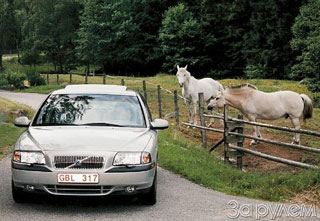 switching. Movement from yourself is an increased transmission, reduced to yourself. The impression of the mechanism is not bad. When accelerating, it makes it possible to promote the engine to the maximum permissible speed, when slowing down - to slow down, switching to a low gear. The usual machines do not give any one or the other.
switching. Movement from yourself is an increased transmission, reduced to yourself. The impression of the mechanism is not bad. When accelerating, it makes it possible to promote the engine to the maximum permissible speed, when slowing down - to slow down, switching to a low gear. The usual machines do not give any one or the other. Electronic attack
The car is literally stuffed with complex electronics, which controls active and passive safety systems, provides comfort and protection against theft. There is a full electric package, musical installation, orientation system, cruise control, climatic installation, an alarm mounted at the factory with a built-in immobilizer. For the ability of the car, the systems of ABS, electronic distribution of brake forces, stabilization and control of traction are responsible in the accident.
 In addition to traditional passive safety funds for Volvo, two new items have appeared. One is an inflated curtain (IS). It is hidden under the upholstery of the ceiling between the front and rear side racks. When hitting on board, the curtain is inflated and softens the heads of the head on the lateral glass or body racks. Another protection is from injuries of the neck and spine when hitting behind. She fundamentally changed the design of the seats. In the collision, the back and headrest move back along a complex trajectory, supporting the upper body and extinguishing the energy of the blow.
In addition to traditional passive safety funds for Volvo, two new items have appeared. One is an inflated curtain (IS). It is hidden under the upholstery of the ceiling between the front and rear side racks. When hitting on board, the curtain is inflated and softens the heads of the head on the lateral glass or body racks. Another protection is from injuries of the neck and spine when hitting behind. She fundamentally changed the design of the seats. In the collision, the back and headrest move back along a complex trajectory, supporting the upper body and extinguishing the energy of the blow. A business person will be pleased with the GSM standard, integrated into the dashboard with a free hand function. Buttons for recruiting the number - on the central console, the microphone - in the intra -axial rear -view mirror, the speaker - in the headset of the driver’s seat, and the buttons control are located on the steering wheel. The rear seat passengers have a tube built into the central armrest. An attempt to call a car flying along the Swedish highway to Moscow was immediately crowned with success. The audibility, I note, was excellent.
 But in addition to the electronic systems themselves, the car has another rash. The Volvo S80 is equipped with an improved multiplex type electrical wiring, which is new for serial automobile communication systems. The electrical components are combined into a network consisting of 18 computers with a central control device and 24 or more executive modules for the implementation of certain functions.
But in addition to the electronic systems themselves, the car has another rash. The Volvo S80 is equipped with an improved multiplex type electrical wiring, which is new for serial automobile communication systems. The electrical components are combined into a network consisting of 18 computers with a central control device and 24 or more executive modules for the implementation of certain functions. Multiplex technology allows you to use only two cables. The first transmits all the signals arising in the system. The second gives food. These cable lines are laid throughout the car and are well protected from external influences. Information on the network is transmitted in the form of digital packages.
Applying multiplex technology, much reduced the number of chains and connections. The connection between all components of electrical equipment became more reliable, it is easier to look for a malfunction. Another undoubted plus of the latest technology - the electronics of the car are programmed directly at the factory in accordance with the wishes of the customer. Moreover, it remains the opportunity at any time to simplify and complicate the software of the car.
 Short trial trips confirmed the properties that have become traditional for Volvo cars. The S80 sedan is comfortable, its interior is spacious, the quality of the finish and sound insulation meet the class of the machine. Wast qualities and accelerated dynamics are excellent. Safety and environmental cleanliness - the horse of the Swedish company. For example, Volvo S80 2.9 received a kind of certificate of the Institute of Independent Inspectors Lloyd's Register. It reflects the environmental indicators of the entire life cycle of the car: production - operation - processing.
Short trial trips confirmed the properties that have become traditional for Volvo cars. The S80 sedan is comfortable, its interior is spacious, the quality of the finish and sound insulation meet the class of the machine. Wast qualities and accelerated dynamics are excellent. Safety and environmental cleanliness - the horse of the Swedish company. For example, Volvo S80 2.9 received a kind of certificate of the Institute of Independent Inspectors Lloyd's Register. It reflects the environmental indicators of the entire life cycle of the car: production - operation - processing. Only one question has remained open. Will Volvo, promising to release a new model every year, maintain a high level of quality and reliability. Of course, no one expected such a powerful electronic attack, but the development of new technologies rarely goes smoothly. Let's hope that the Scandinavians are still distinguished by the balanced solutions, and if they got involved in an electronic struggle, then this step was thoroughly prepared.
TECHNICAL SPECIFICATIONS
vOLVO S80 car 2.9
(in brackets - different parameters of the S80 T6 BURBO with an automatic gearbox)
General data: number of places - 5; Equipped mass - 1489 kg; maximum speed - 235 (250) km/h; acceleration time from a place to 100 km/h - 8.2 (7.2) s; The average fuel consumption is 9.7 (10.9) l/100 km; fuel supply - 80 liters; Fuel is unhealthy gasoline AI-98, AI-95. Dimensions, mm: length - 4820; width - 1830; height - 1450; base - 2790; The track in front/back - 1580/1560; Road clearance - 150; The volume of the trunk is 440 liters. Engine: a six -cylinder in order, with distributed injection, is located in front of the front; working volume - 2922 (2783) SMZ; the number of valves per cylinder is 4; compression degree - 10.5 (8.5); Power - 150 kW/204 hp at 6000 rpm (200 kW/272 l. p. at 5400 rpm); The maximum torque is 280 N.M at 4200 rpm (380 N.M at 2000-5000 rpm). Transmission: front wheel drive, gearbox - five -speed mechanical (four -speed automatic); Transporting numbers: I - 3.07 (2.92); II - 1.77 (1.57); III - 1.19 (1.00); IV - 0.87 (0.70); V - 0.70; Z.Kh. - 2.50 (2.38); The main program is 4.25 (3.29). Suspension: front - independent type of McExon, with a reptile stability stabilizer; The back is a semi -dependent delta -link with transverse levers, spring racks and a reptile stabilizer. Brakes: hydraulic with a vacuum amplifier; Front - ventilated disk, rear - disk. Wheels: 15 or 16 inches.
Vadim Kryuchkov. Photo by the author and Volvo
Source: The magazine "Driving"
Video Crash tests Volvo S80 1998 - 2003
Test drives Volvo S80 1998 - 2003
Krash Test Volvo S80 1998 - 2003
Krassh Test: Detailed Information29%
Driver and passengers
14%
Pedestrians



